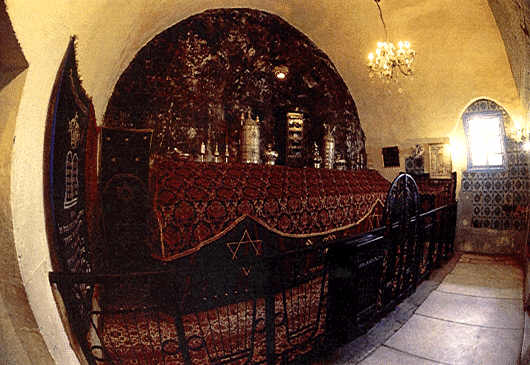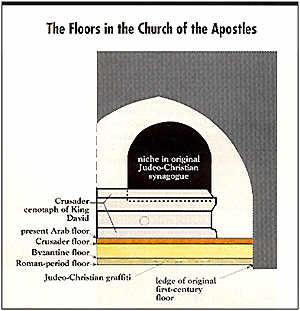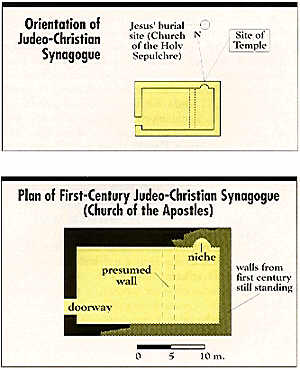


 King David's traditional tomb (above), as it is erroneously identified, on Zion III. Venerated at various times by Jews,
Moslem and Christians, this stone cenotaph, placed here by the Crusaders, lies draped in velvet cloth before a niche blackened by pilgrim's candles.
An unexpected opportunity to investigate this building occured in 1948, during Israel's War of Independence. A mortar shell hit the site, and Israeli archaeologist Jacob Pinkerfeld was sent to repair the damage. In the course of repairs, he removed the marble floor slabs and dug two pits revealing three earlier floors, shown in the lower left drawing. Five inches below the present floor was a 12th-century Crusader floor; 1.5 feet below that, Pinkerfeld discovered a mosaic floor with geometric designs dating to the Byzantine period (fifth century); 4 inches below the mosaic, he uncovered the remains of a Roman floor (end of the first century), consisting of plaster fragments and stones from a possible pavement. A foundation ledge projecting into the hall at this final level indicated that this earlier Roman floor was the original building's floor.
King David's traditional tomb (above), as it is erroneously identified, on Zion III. Venerated at various times by Jews,
Moslem and Christians, this stone cenotaph, placed here by the Crusaders, lies draped in velvet cloth before a niche blackened by pilgrim's candles.
An unexpected opportunity to investigate this building occured in 1948, during Israel's War of Independence. A mortar shell hit the site, and Israeli archaeologist Jacob Pinkerfeld was sent to repair the damage. In the course of repairs, he removed the marble floor slabs and dug two pits revealing three earlier floors, shown in the lower left drawing. Five inches below the present floor was a 12th-century Crusader floor; 1.5 feet below that, Pinkerfeld discovered a mosaic floor with geometric designs dating to the Byzantine period (fifth century); 4 inches below the mosaic, he uncovered the remains of a Roman floor (end of the first century), consisting of plaster fragments and stones from a possible pavement. A foundation ledge projecting into the hall at this final level indicated that this earlier Roman floor was the original building's floor.
Two pieces of evidence suggest that this synagogue was built by Judeo-Christians, rather than by traditional Jews. The first consists of several fragments of plaster scattered on the earliest floor and bearing graffiti, apparently Christian, from the building's original walls.
The second piece of evidence is the orientation of the synagogue's niche. If the structure had been a traditional Jewish synagogue, its niche should have been oriented toward the Temple Mount, where the Temple had stood until its destruction in A.D. 70. The builders had a clear view of the Temple site, and yet they oriented the synagogue niche slightly east of north, on a direct line with the Church of the Holy Sepulchre, the traditional site of Jesus' crucifixion and burial (see the synagogue's floor plan and orientation in the drawings above left).
History provides a third reason to identify this synagogue as Judeo-Christian in origin. It was probably built in the late first century, after the Romans had destroyed Jerusalem, a time when traditional Jews were not building synagogues in Jerusalem. Our author suggests that Judeo-Christians constructed this synagogue after their return to Jerusalem from Pella, in today's Jordan, where they had fled shortly before the Temple was destroyed by the Romans. They chose to build their synagogue on Zion III because they remembered this as the place where the last Supper occurred, where the apostles returned after witnessing the ascension of Jesus and when Peter delivered his sermon after the Holy Spirit had descended upon the apostles on Pentecost. The room immediately above the "Tomb of David" is dedicated to the descent of the Holy Spirit on Pentecost and is called "Chapel of the Holy Spirit."
CenturyOne Foundation http://www.centuryone.com/foundation.html
From Biblical Archaeology Review 1990